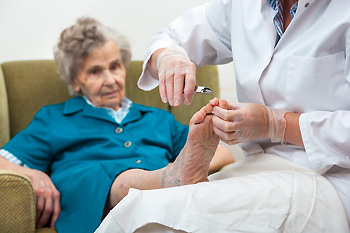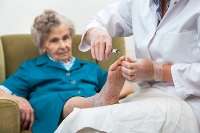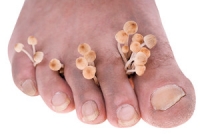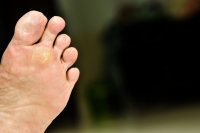
Blog (807)
Proper Winter Footwear
According to the American College of Foot and Ankle Surgeons (ACFAS), it’s important to keep your feet safe during the winter months with proper footwear. Proper winter footwear should provide traction against the snow and icy surfaces. The footwear should also keep your feet warm, insulated, and be water-resistant. Proper protection can help ward off against poor blood circulation caused by the cold. Wearing breathable, moisture-resistant socks can also offer greater protection, as keeping the feet dry is just as important as keeping them warm.
Finding a properly-fitting shoe is important in reducing injuries and preventing foot problems. For more information about treatment, contact Dr. Kenneth Donovan from Advanced Care Foot and Ankle. Our doctor will treat your foot and ankle needs.
Proper Shoe Fitting
A common concern when it comes to foot health, having properly fitted shoes can help prevent injuries to the foot. Out feet affect our posture and gait, which in turn affects the biomechanics and overall bodily structure. With 33 joints, 26 bones, and over 100 ligaments, the potential for serious injury is much greater than one realizes. Although the feet cease growth in adulthood, they still change shape as they mature. Here are some factors to consider when it comes to investing in proper fitting shoes:
- Be sure the shoes fit correctly right away
- Ensure the ball of your foot fits comfortably in the widest portion of the shoes
- Even though they may look fashionable, improper fitting shoes can either create adverse conditions or exacerbate existing ones you may already have
- Walk along a carpeted surface to ensure the shoes comfortably fit during normal activity
Keeping in mind how shoes fit the biomechanics of your body, properly-fitting shoes are vitally important. Fortunately, it is not difficult to acquire footwear that fits correctly. Be sure to wear shoes that support the overall structure of your body. Do your feet a favor and invest in several pairs of well-fitted shoes today.
If you have any questions, please feel free to contact our offices located in New Jersey. We offer the newest diagnostic tools and technologies to treat your foot and ankle needs.
Tennessee Titans CB Suffers Ankle Injury
Unfortunate news for Tennessee Titans fans…cornerback Logan Ryan has suffered an ankle injury of unknown severity during the Titans and San Francisco 49ers game.
He sustained the injury during the second quarter, and it forced Ryan off the field for the rest of the game.
The severity of the injury has not been announced, nor just how long Ryan will be out for.
It is expected that fellow teammates Brice McCain and LeShaun Sims will take his place until he returns.
Sports related foot and ankle injuries require proper treatment before players can go back to their regular routines. For more information, contact Dr. Kenneth Donovan of Advanced Care Foot and Ankle. Our doctor can provide the care you need to keep you pain-free and on your feet.
Sports Related Foot and Ankle Injuries
Foot and ankle injuries are a common occurrence when it comes to athletes of any sport. While many athletes dismiss the initial aches and pains, the truth is that ignoring potential foot and ankle injuries can lead to serious problems. As athletes continue to place pressure and strain the area further, a mild injury can turn into something as serious as a rupture and may lead to a permanent disability. There are many factors that contribute to sports related foot and ankle injuries, which include failure to warm up properly, not providing support or wearing bad footwear. Common injuries and conditions athletes face, including:
- Plantar Fasciitis
- Plantar Fasciosis
- Achilles Tendinitis
- Achilles Tendon Rupture
- Ankle Sprains
Sports related injuries are commonly treated using the RICE method. This includes rest, applying ice to the injured area, compression and elevating the ankle. More serious sprains and injuries may require surgery, which could include arthroscopic and reconstructive surgery. Rehabilitation and therapy may also be required in order to get any recovering athlete to become fully functional again. Any unusual aches and pains an athlete sustains must be evaluated by a licensed, reputable medical professional.
If you have any questions please feel free to contact one of our offices located in Warren, Livingston, and Toms River, NJ. We offer the newest diagnostic and treatment technologies for all your foot and ankle needs.
Tennessee Titans CB Suffers Ankle Injury
 Unfortunate news for Tennessee Titans fans...cornerback Logan Ryan has suffered an ankle injury of unknown severity during the Titans and San Francisco 49ers game. He sustained the injury during the second quarter, and it forced Ryan off the field for the rest of the game. The severity of the injury has not been announced, nor just how long Ryan will be out for. It is expected that fellow teammates Brice McCain and LeShaun Sims will take his place until he returns.
Unfortunate news for Tennessee Titans fans...cornerback Logan Ryan has suffered an ankle injury of unknown severity during the Titans and San Francisco 49ers game. He sustained the injury during the second quarter, and it forced Ryan off the field for the rest of the game. The severity of the injury has not been announced, nor just how long Ryan will be out for. It is expected that fellow teammates Brice McCain and LeShaun Sims will take his place until he returns.
Sports related foot and ankle injuries require proper treatment before players can go back to their regular routines. For more information, contact Dr. Kenneth Donovan of Advanced Care Foot and Ankle. Our doctor can provide the care you need to keep you pain-free and on your feet.
Sports Related Foot and Ankle Injuries
Foot and ankle injuries are a common occurrence when it comes to athletes of any sport. While many athletes dismiss the initial aches and pains, the truth is that ignoring potential foot and ankle injuries can lead to serious problems. As athletes continue to place pressure and strain the area further, a mild injury can turn into something as serious as a rupture and may lead to a permanent disability. There are many factors that contribute to sports related foot and ankle injuries, which include failure to warm up properly, not providing support or wearing bad footwear. Common injuries and conditions athletes face, including:
- Plantar Fasciitis
- Plantar Fasciosis
- Achilles Tendinitis
- Achilles Tendon Rupture
- Ankle Sprains
Sports related injuries are commonly treated using the RICE method. This includes rest, applying ice to the injured area, compression and elevating the ankle. More serious sprains and injuries may require surgery, which could include arthroscopic and reconstructive surgery. Rehabilitation and therapy may also be required in order to get any recovering athlete to become fully functional again. Any unusual aches and pains an athlete sustains must be evaluated by a licensed, reputable medical professional.
If you have any questions please feel free to contact one of our offices located in Warren, Livingston, and Toms River, NJ . We offer the newest diagnostic and treatment technologies for all your foot and ankle needs.
Keeping the Feet Healthy as We Age
Many seniors develop foot issues as they age, commonly due to loss of strength resulting from lack of exercise. Walking helps to maintain healthy feet, which aids in keeping the body balanced, therefore preventing falls. Good everyday foot care practices are crucial in avoiding foot problems and may include washing the feet daily, trimming toenails often, and keeping the skin moisturized to avoid cracked heels. Avoiding tight socks, elevating the feet, and wiggling your toes while sitting for long periods of time may benefit general foot health. Buying shoes with closed toes and low heels will not only protect your feet from injury, but may prevent falling and tripping. Checking the feet daily for any type of redness, swelling, or possible infected toenails is also important in keeping the feet healthy. If you have any questions about how to properly maintain the feet as you age, contact a podiatrist.
If you need your feet checked, contact Dr. Kenneth Donovan of Advanced Care Foot and Ankle. Our doctor will attend to all of your foot and ankle needs and provide you with quality treatment.
Geriatrics and Podiatry
When people age, some common issues that may occur are bone density loss, dry skin, poor circulation, and rough brittle nails. These issues may also affect your foot health if the necessary steps are not taken to alleviate the problems.
It is important to take care of your feet because feet that are injured or diseased can affect your overall health.
Having painful feet hinders your ability to do daily activities or may decrease your willingness to do the things that you need to do.
Visiting Your Geriatrician
As we age, health problems become more likely, so it is essential to visit your doctor for check-ups to ensure that you are doing the best you can to take care of your health. It is recommended to check your feet frequently for any possible cuts, bruises, swelling, corns or any other irregularities.
Taking Care of Elderly Feet
Cracked or dry feet can be treated by applying moisturizer often. It is also important not to wear old socks because the older the sock is, the higher the possibility there will be that there is bacteria there. Wear fresh socks and make sure they fit properly.
Proper foot health means that you can have a more active lifestyle and you will not be bogged down by pain. Foot health also leads to good circulation, which is paramount for overall health.
If you have any questions, please feel free to contact one of our offices located in Warren, Livingston, and Toms River, NJ. We offer the newest diagnostic tools and technology to treat your foot and ankle needs.
Keeping the Feet Healthy as We Age
 Many seniors develop foot issues as they age, commonly due to loss of strength resulting from lack of exercise. Walking helps to maintain healthy feet, which aids in keeping the body balanced, therefore preventing falls. Good everyday foot care practices are crucial in avoiding foot problems and may include washing the feet daily, trimming toenails often, and keeping the skin moisturized to avoid cracked heels. Avoiding tight socks, elevating the feet, and wiggling your toes while sitting for long periods of time may benefit general foot health. Buying shoes with closed toes and low heels will not only protect your feet from injury, but may prevent falling and tripping. Checking the feet daily for any type of redness, swelling, or possible infected toenails is also important in keeping the feet healthy. If you have any questions about how to properly maintain the feet as you age, contact a podiatrist.
Many seniors develop foot issues as they age, commonly due to loss of strength resulting from lack of exercise. Walking helps to maintain healthy feet, which aids in keeping the body balanced, therefore preventing falls. Good everyday foot care practices are crucial in avoiding foot problems and may include washing the feet daily, trimming toenails often, and keeping the skin moisturized to avoid cracked heels. Avoiding tight socks, elevating the feet, and wiggling your toes while sitting for long periods of time may benefit general foot health. Buying shoes with closed toes and low heels will not only protect your feet from injury, but may prevent falling and tripping. Checking the feet daily for any type of redness, swelling, or possible infected toenails is also important in keeping the feet healthy. If you have any questions about how to properly maintain the feet as you age, contact a podiatrist.
If you need your feet checked, contact Dr. Kenneth Donovan of Advanced Care Foot and Ankle. Our doctor will attend to all of your foot and ankle needs and provide you with quality treatment.
Geriatrics and Podiatry
When people age, some common issues that may occur are bone density loss, dry skin, poor circulation, and rough brittle nails. These issues may also affect your foot health if the necessary steps are not taken to alleviate the problems.
It is important to take care of your feet because feet that are injured or diseased can affect your overall health. Having painful feet hinders your ability to do daily activities or may decrease your willingness to do the things that you need to do.
Visiting Your Geriatrician
As we age, health problems become more likely, so it is essential to visit your doctor for check-ups to ensure that you are doing the best you can to take care of your health. It is recommended to check your feet frequently for any possible cuts, bruises, swelling, corns or any other irregularities.
Taking Care of Elderly Feet
Cracked or dry feet can be treated by applying moisturizer often. It is also important not to wear old socks because the older the sock is, the higher the possibility there will be that there is bacteria there. Wear fresh socks and make sure they fit properly.
Proper foot health means that you can have a more active lifestyle and you will not be bogged down by pain. Foot health also leads to good circulation, which is paramount for overall health.
If you have any questions, please feel free to contact one of our offices located in Warren, Livingston, and Toms River, NJ . We offer the newest diagnostic tools and technology to treat your foot and ankle needs.
Read more about Geriatrics and PodiatryHow to Avoid Toenail Fungus
Toenail fungus, also known as onychomycosis, is a relatively common health condition. Common symptoms of toenail fungus include yellow or brown nails, brittleness, or nails that may lift up from the nail bed. The fungus is contagious and can spread from nail to nail or even infect the foot and cause athlete’s foot. Without treatment, the fungus can worsen, which may be a contributing factor in experiencing pain while wearing shoes. Avoiding toenail fungus is important in maintaining healthy feet. Choosing breathable footwear, wearing proper shoes in public showers, and using foot powders to keep the feet dry can all help in avoiding toenail fungus. Keeping toenails short is also important and aids in preventing ingrown toenails. Additionally, it’s advised that shoes or nail clippers should not be shared, as this may promote spreading of the fungus. If a pedicure is desired, it’s important that the sanitation of pedicure tools occur. For all conditions related to the foot, including toenail fungus, it is important to seek help from a podiatrist.
For more information about treatment, contact Dr. Kenneth Donovan of Advanced Care Foot and Ankle. Our doctor can provide the care you need to keep you pain-free and on your feet.
Toenail Fungus Treatment
Toenail fungus is a condition that affects many people and can be especially hard to get rid of. Fortunately, there are several methods to go about treating and avoiding it.
Antifungals & Deterrence
Oral antifungal medicine has been shown to be effective in many cases. It is important to consult with a podiatrist to determine the proper regiment for you, or potentially explore other options.
Applying foot powder on the feet and shoes helps keep the feet free of moisture and sweat.
Sandals or open toed shoes – Wearing these will allow air movement and help keep feet dry. They also expose your feet to light, which fungus cannot tolerate. Socks with moisture wicking material also help as well.
If you have any questions please feel free to contact one of our offices located in Warren, Livingston, and Toms River, NJ . We offer the newest diagnostic tools and technology to treat your foot and ankle needs.
Do Your Child’s Feet Hurt?
Do Your Child's Feet Hurt?
What is Hyperhidrosis?
The purpose of sweating is to regulate the body’s temperature. When this happens excessively, it’s known as hyperhidrosis. Most of the millions of people affected by this condition often feel a loss of control because sweating can occur independent of physical exertion. It may begin in childhood and is thought to be a genetically inherited condition. In severe cases, sweat can drip from the feet, possibly causing social situations to be uncomfortable. Anxiety, depression, infections and skin irritations may occur, resulting in difficulty in handling this condition psychologically. Typically, it helps to identify specific conditions that lead to excessive sweating. To reduce discomfort, keeping the feet dry is advised. Medications and surgery are possible treatment options to regulate this disorder. Please consult with a podiatrist if you have questions about excessive sweating from the feet.
If you are suffering from hyperhidrosis contact Dr. Kenneth Donovan of Advanced Care Foot and Ankle. Our doctor can provide the care you need to attend to all of your foot and ankle needs.
Hyperhidrosis of the Feet
Hyperhidrosis is a rare disorder that can cause people to have excessive sweating of their feet. This can usually occur all on its own without rigorous activity involved. People who suffer from hyperhidrosis may also experience sweaty palms.
Although it is said that sweating is a healthy process meant to cool down the body temperature and to maintain a proper internal temperature, hyperhidrosis may prove to be a huge hindrance on a person’s everyday life.
Plantar hyperhidrosis is considered to be the main form of hyperhidrosis. Secondary hyperhidrosis can refer to sweating that occurs in areas other than the feet or hands and armpits. Often this may be a sign of it being related to another medical condition such as menopause, hyperthyroidism and even Parkinson’s disease.
In order to alleviate this condition, it is important to see your doctor so that they may prescribe the necessary medications so that you can begin to live a normal life again. If this is left untreated, it is said that it will persist throughout an individual’s life.
A last resort approach would be surgery, but it is best to speak with your doctor to find out what may be the best treatment for you.
If you have any questions please feel free to contact one of our offices located in Warren, Livingston, and Toms River, NJ. We offer the newest diagnostic and treatment technologies for all your foot and ankle needs.
Why Are My Feet Cold?
The feet may feel cold when there are environmental stresses, such as the temperature dropping. This may cause oxygen deficiency and turn the feet blue in color, a condition called cyanosis. When the natural circulation is restored, this condition disappears. There are other causes of poor blood circulation, including the inability to produce normal levels of red blood cells, commonly known as anemia. Typically, improvement may be achieved through diet, in addition to taking nutritional supplements. Diabetes may be another cause, and this disease can have very serious effects on the feet. It may result in nerve damage, causing the feet to feel cold. If your feet feel cold a lot of the time, a consultation with a podiatrist may be advised.
Poor circulation is a serious condition and needs immediate medical attention. If you have any concerns with poor circulation in your feet contact Dr. Kenneth Donovan of Advanced Care Foot and Ankle. Our doctor will treat your foot and ankle needs.
Poor Circulation in the Feet
Poor blood circulation in the feet and legs is can be caused by peripheral artery disease (PAD), which is the result of a buildup of plaque in the arteries.
Plaque buildup or atherosclerosis results from excess calcium and cholesterol in the bloodstream. This can restrict the amount of blood which can flow through the arteries. Poor blood circulation in the feet and legs are sometimes caused by inflammation in the blood vessels, known as vasculitis.
Causes
Lack of oxygen and oxygen from poor blood circulation restricts muscle growth and development. It can also cause:
- Muscle pain, stiffness, or weakness
- Numbness or cramping in the legs
Those who have diabetes or smoke are at greatest risk for poor circulation, as are those who are over 50. If you have poor circulation in the feet and legs it may be caused by PAD and is important to make changes to your lifestyle in order to reduce risk of getting a heart attack or stroke. Exercise and maintaining a healthy lifestyle will dramatically improve conditions.
As always, see a podiatrist as he or she will assist in finding a regimen that suits you. A podiatrist can also prescribe you any needed medication.
If you have any questions please feel free to contact one of our offices located in Warren, Livingston, and Toms River, NJ. We offer the newest diagnostic and treatment technologies for all your foot and ankle needs.
Read more about Causes, Symptoms, and Treatment of Poor Blood Circulation in the Feet











